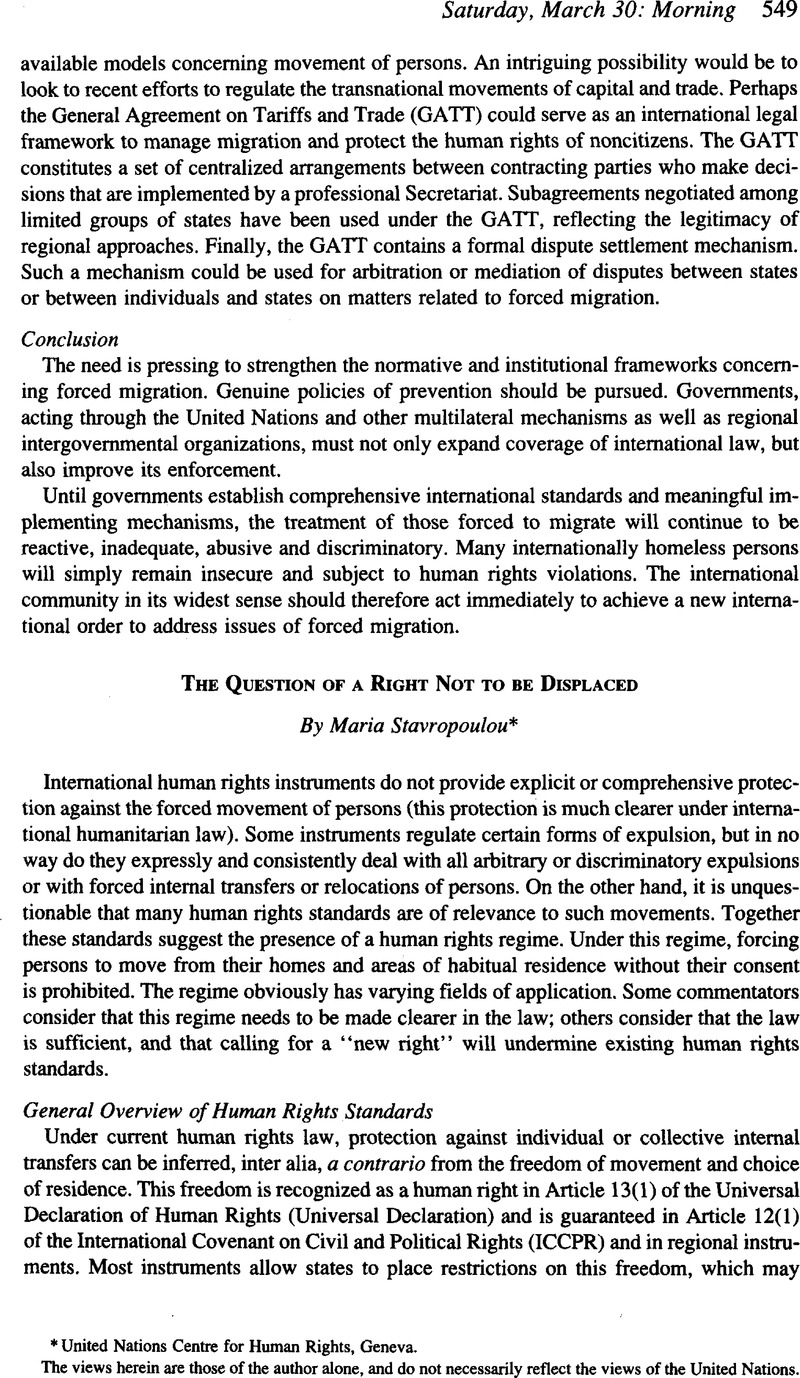Article contents
The Question of a Right Not to be Displaced
Published online by Cambridge University Press: 17 February 2017
Abstract

- Type
- Forced Movement of Peoples
- Information
- Copyright
- Copyright © American Society of International Law 2015
References
1 The Siracusa Principles on the Limitation and Derogation Provisions in the International Covenant on Civil and Political Rights, 7 Hum. Rts. Q. 3,4 (1985). For a thorough analysis of the principles of necessity and proportionality and of the grounds on which Articles 12 and 17 of the ICCPR can be restricted, see Manfred Nowak, UN Covenant on Civil and Political Rights, CCPR Commentary 206–217, 302 (1993) and Individual Communication pursuant to the Optional Protocol I to the ICCPR No. 24/1977, Sandra Lovelace v. Canada reproduced in Human Rights Committee, Selected Decisions under the Optional Protocol, UN Doc. CCPR/C/OP/1 (1985).
2 General Comment of the Committee on Economic, Social and Cultural Rights, No. 4, para. 7; General Comments of the Committee of Economic, Social and Cultural Rights, Nos. 1–4, reprinted in Note by the Secretariat, Compilation of General Comments and General Recommendations adopted by Human Rights Treaty Bodies, UN Doc. HRI/GEN/1/Rev. 1 (29 July 1994).
3 Id., para. 18.
4 Article 12(4) of the ICCPR guarantees the right to return to one's “own“ country, as opposed to the country of which the person is a national. This distinction indicates that the protection extends to persons who have such a strong attachment to a state that they view it as their “own“ or home country. This includes permanent alien residents and in some instances stateless persons and refugees. See Jean-Marie Henckaerts, Mass Expulsion in Modern International Law and Practice 83–99 (1995).
5 See., e.g., M. Nowak, at 218; Henckaerts, at 78.
6 See, e.g., Protocol 4 of the European Convention on Human Rights and Articles 3(1) and 12(4) of the ICCPR. See also Article 13 of the ICCPR and Article 12(4) of the African Charter, from which it is inferred a contrario that arbitrary expulsion of citizens is also prohibited.
7 See Article 31 of the 1954 Convention Relating to the Status of Stateless Persons.
8 See Article 32 of the 1951 Convention Relating to the Status of Refugees.
9 See Cartagena Declaration on Refugees, Conclusions III, 5, adopted by the Colloquium on the International Protection of refugees in Central America, Mexico and Panama, held in Cartagena in 1994, reprinted in UNHCR, 2 Collection of International Instruments and other Legal Texts Concerning Refugees and Displaced Persons 206, 208 (1995).
10 International Convention on the Protection of the Rights of All Migrant Workers and Members of Their Families, adopted by General Assembly Resolution 45/158 of Dec. 18, 1990 (not in force).
11 ILO Convention No. 97 Concerning Migration for Employment, accompanying Recommendation 86, Convention No. 43 Concerning Migrant Workers and accompanying Recommendation No. 151, and Article 25 of Model Agreement attached to Recommendation 86.
12 J. Henckaerts, at 47–48. This is made explicit in Article 12(5) of the African Charter on Human and People's Rights.
13 Report Submitted by Bosnia and Hercegovina pursuant to a Special Decision Taken by the Committee, UN Doc. CERD/C/247/Add.l (1993).
14 UN Doc. A/50/18, para. 219 (1995).
15 Articles 6(b) and 6(c) of the Charter of the International Military Tribunal, International Military Tribunal, 1 Trial of the Major War Criminals Before The International Military Tribunal (IMT) 11 (1947–1949).
16 2 Yearbook of the International Law Commission (1991), UN Doc. A/CN.4/SER.A/1991/Add.l (Part 2), at 103–105.
17 Report of the Secretary-General pursuant to paragraph 2 of Security Council Resolution 808 (1992), UN Doc. S/25704.
18 S.C. Res. 955, UN SCOR, 50th Sess., UN Doc. S/RES/955 (1995).
19 These basic norms have largely been explicitly recognized in relation to indigenous peoples, for whom legal protections from being removed for their homes and environments have been enunciated in several international legal instruments. These include the Convention Concerning Indigenous and Tribal Peoples in Independent Countries, ILO Convention No. 169, entered into force Sept. 5, 1991, reprinted in International Labour Organisation, 2 International Labour Conventions and Recommendations, 1919–1991 (1992) [hereinafter ILO Convention No. 169]; and ILO Convention No. 107, which ILO Convention No. 169 replaced, and accompanying Recommendation No. 104. Both conventions have been criticized for lack of specificity with regard to the legal basis for the displacement of indigenous peoples. These issues are addressed in detail in the UN Draft Declaration on the Rights of Indigenous Peoples, as adopted by the Sub-Commission at its forty-sixth session, UN Doc. E/CN.4/Sub.2/1994/2/Add.l.
20 Accord, Awn Shawhat Al-Khasaneh, The human rights dimensions of population transfer including the implantation of settlers, UN Doc. E/CN.4/Sub.2/1994/18, para. 19 (1994).
21 C. Palley, The human rights dimensions of populations transfers: Preliminary working paper UN Doc. No. E/CN.4/Sub.2/ 1992/WP. 1.
22 Id.
23 Goodwin-Gill, Guy, The Right to Leave, the Right to Return, and the Question of a Right to Remain in The Problem of Refugees in the Light of Contemporary International Law Issues 93,94 (Vera, Gowlland- Debbas ed., 1995)Google Scholar.
24 Id.
25 Hathaway, James C., New Directions to Avoid Hard Problems: The Distortion of the Palliative Role of Refugee Protection, 8 J. of Refugee Stud. 288, 293 (1995)Google Scholar.
26 Accord Goebel, Christopher M., A Unified Concept of Population Transfer (Revised), 22 Denv. J. Int'l L. & Pol'y 26–27 (1993); Meindersma, Christa, Legal Issues Surrounding Population Transfers in Conflict Situations, XLI Neth. Int'l L. Rev. 35, 81 (1994)Google Scholar.
27 J. Hathaway, at 292.
28 J. Hathaway, at 293.
29 See generally J. Hathaway.
30 UN Doc. E/CN.4/1503.
- 2
- Cited by




